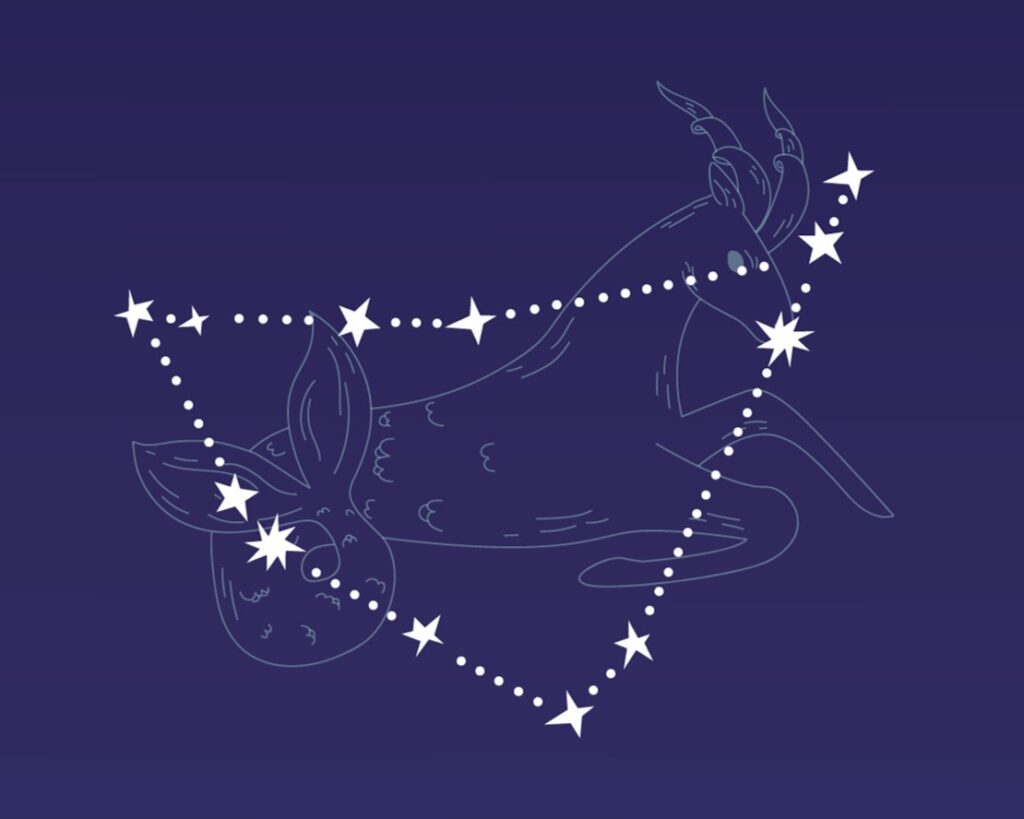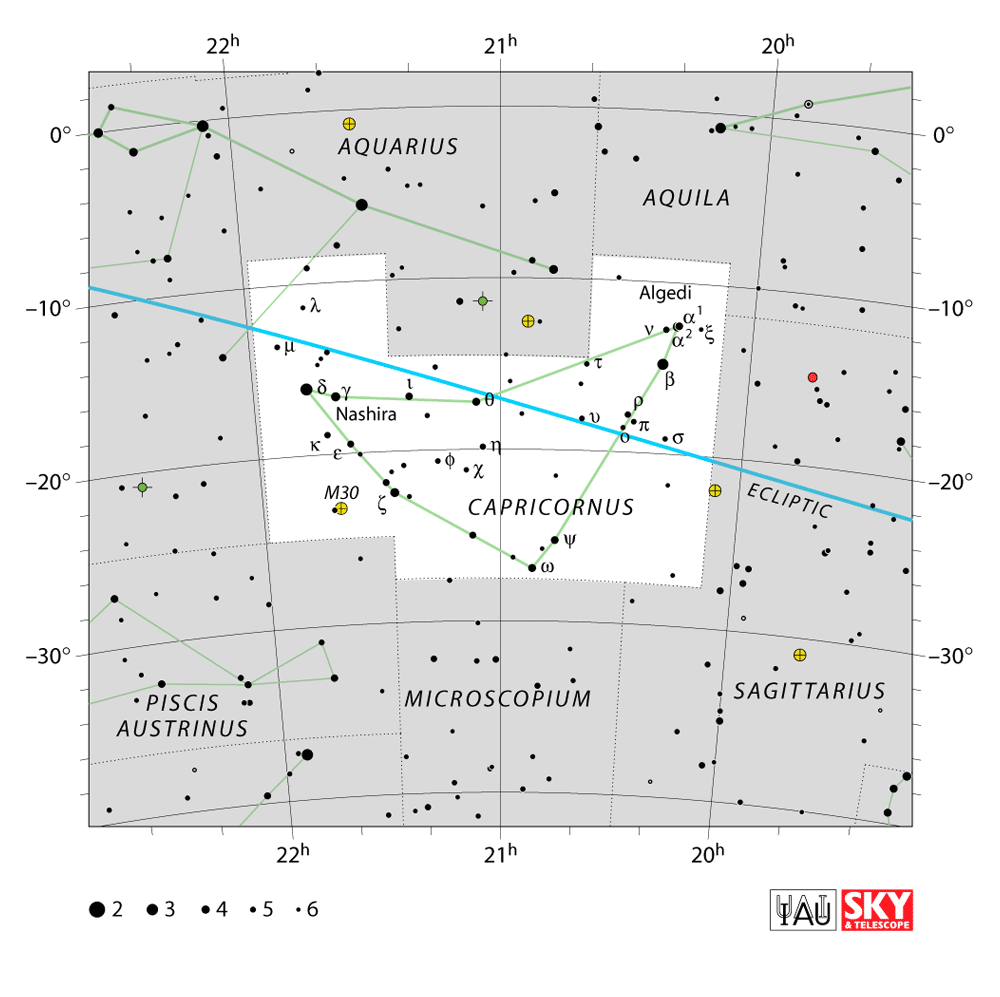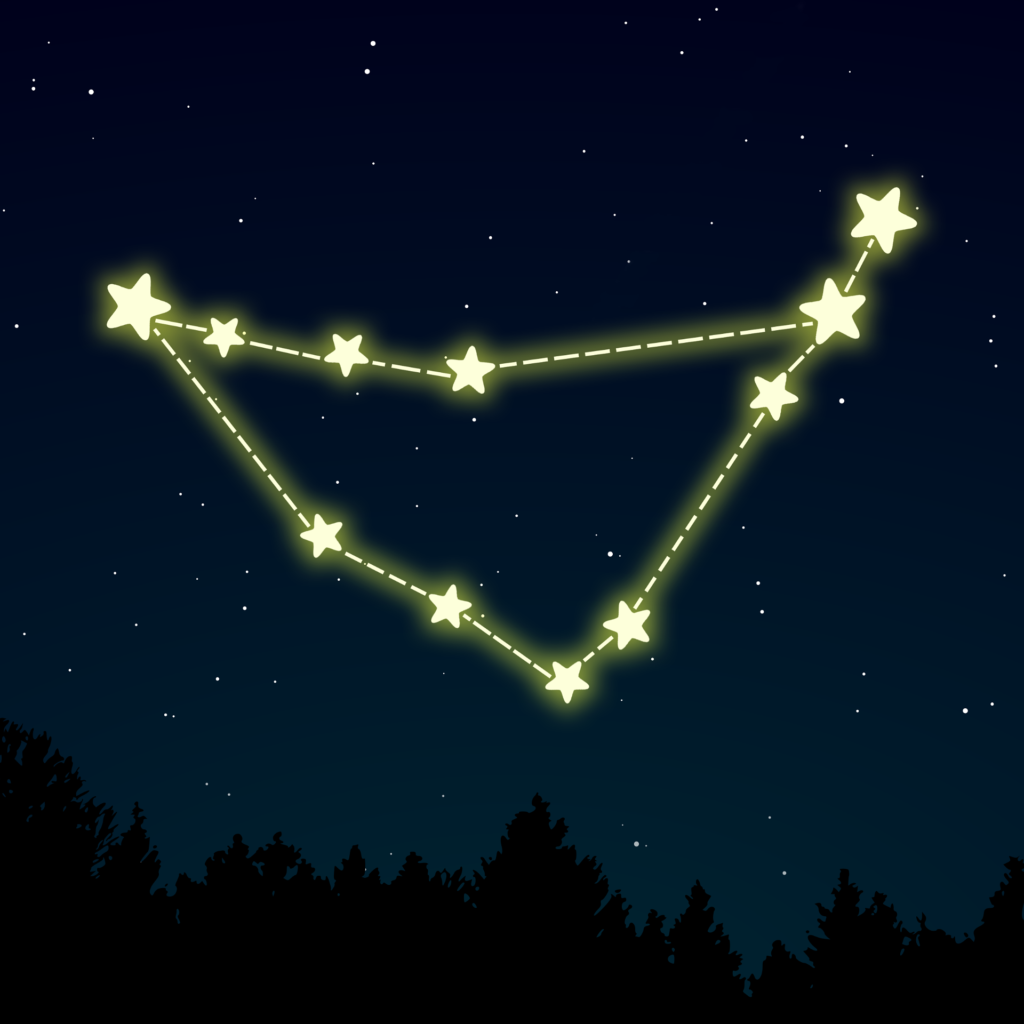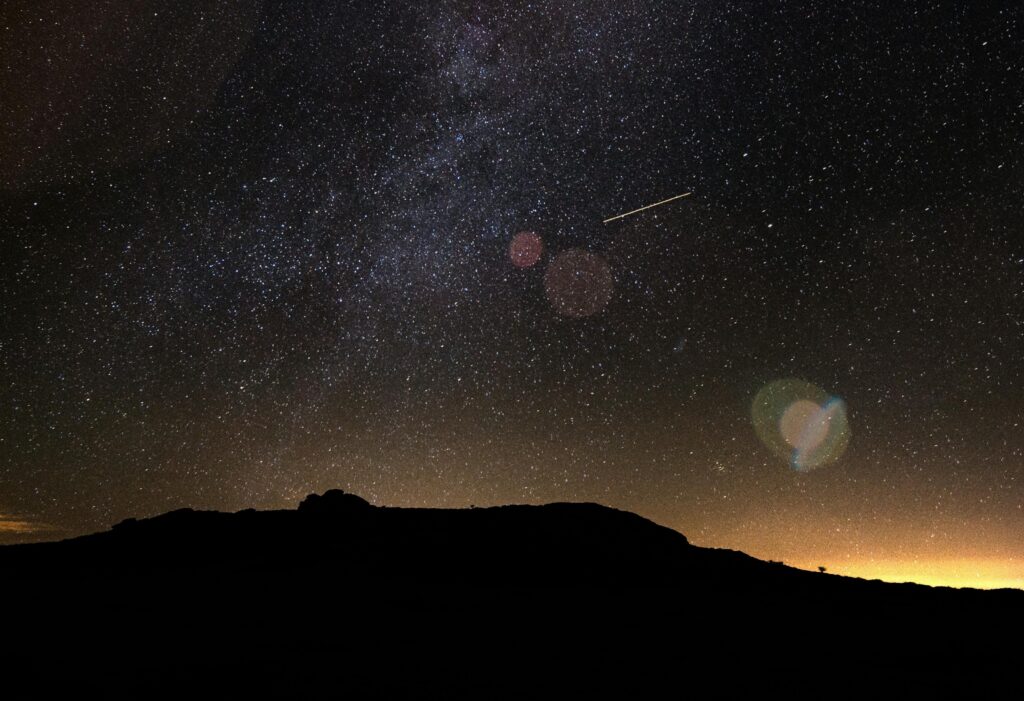Stargazing with Capricornus
© freepik/tartila
Capricornus, commonly known as Capricorn, is one of the zodiacal constellations, representing a sea goat in ancient mythology. It is positioned in the southern celestial hemisphere and holds significance in both astronomy and astrology. Capricornus is often associated with the winter solstice in the Northern Hemisphere, marking the Sun‘s southernmost point in its annual journey.
Defined by contemporary boundaries, Capricornus shares its borders with Aquila, Sagittarius, Microscopium, Piscis Austrinus, and Aquarius. Resembling a mythical creature with the upper body of a goat and the lower body of a fish, this constellation unveils a celestial ensemble, showcasing stars and features that enhance its cosmic allure. Despite being the smallest constellation in the zodiac, it holds a distinct charm in the night sky.
HISTORY OF CAPRICORNUS

Capricornus, the sea goat, is a constellation steeped in ancient mythology and holds a significant place in the history of astronomy. Its origins can be traced back to various civilizations, each weaving its own stories around this celestial figure.
In Greek mythology, the constellation is often associated with the god Pan. According to one myth, Pan transformed into a fish from the waist down to escape the monster Typhon, and he dove into the Nile River. This amalgamation of goat and fish features in the night sky as Capricornus.
The ancient Babylonians also recognized this region of the sky, and their zodiac system included the constellation Capricornus. They associated it with their god Ea, who was often depicted as a goat-fish hybrid. The constellation’s prominence during the winter solstice likely contributed to its cultural significance.
In Roman mythology, Capricornus is linked to the story of Amalthea, a goat that nursed the infant Zeus. To show gratitude, Zeus placed Amalthea among the stars, immortalizing her as the constellation we see today.
As astronomy advanced in ancient Greece, Ptolemy catalogued Capricornus as one of the 48 constellations in his Almagest during the 2nd century. It became part of the zodiac, an essential component in the study of celestial movements and astrology.
ASTRONOMICAL FEATURES

Capricornus, the sea-goat constellation, is home to several interesting astronomical features that contribute to its celestial allure:
ALPHA CAPRICORNI
Alpha Capricorni, also known by its traditional names Algedi or Giedi, is a binary star system in the constellation Capricornus. Situated approximately 39 light-years away from Earth, Alpha Capricorni consists of two main components, designated Alpha Capricorni A and Alpha Capricorni B. Alpha Capricorni A is a yellow-hued giant star, while Alpha Capricorni B is a smaller companion star. These two stars orbit each other, creating a captivating celestial dance. The binary system is visible to the naked eye, adding to the stellar tapestry of the night sky and serving as a notable point of interest for astronomers and stargazers alike.
DELTA CAPRICORNI
Deneb Algedi, designated as Delta Capricorni, is a binary star system located in the constellation Capricornus. This celestial pair consists of a primary star, Deneb Algedi A, and a fainter companion, Deneb Algedi B. Deneb Algedi A is a white giant star, and its interaction with the smaller companion creates a captivating stellar system. Positioned approximately 39 light-years away from Earth, Deneb Algedi graces the night sky as part of the mythologically rich constellation Capricornus. Despite its faintness, the binary nature of Deneb Algedi adds an intriguing element to the cosmic tableau, offering astronomers and enthusiasts alike a celestial spectacle to explore and appreciate.
THE CAPRICORNUS CLUSTER
The Capricornus Cluster, designated as Messier 30 (M30), is a globular cluster located in the constellation Capricornus. Positioned about 28,000 light-years away from Earth, this stellar gathering comprises a dense collection of stars bound together by gravity. M30 stands out as one of the highlights within Capricornus, showcasing the intricate beauty of celestial communities. Observers equipped with telescopes can delve into the heart of this globular cluster, exploring the myriad stars that form a luminous congregation against the cosmic backdrop. M30’s presence adds a touch of celestial elegance to the constellation, making it a captivating subject for astronomers and stargazers venturing into the depths of the night sky.
CAPRICORNUS DWARF GALAXY
The Capricornus Dwarf Galaxy, also known as Dwarf Spheroidal Galaxy NGC 6907, is a faint and inconspicuous satellite galaxy of the Milky Way situated within the boundaries of the constellation Capricornus. Although challenging to observe due to its low brightness, this dwarf galaxy holds astronomical significance as part of the Milky Way’s retinue of satellite galaxies. With its subtle presence, the Capricornus Dwarf Galaxy contributes to our understanding of the broader cosmic structure and the gravitational interplay within the galactic neighbourhood. Despite its unassuming appearance, the exploration of such dwarf galaxies provides valuable insights into the dynamics and evolution of galactic systems in the vast tapestry of the universe.
THETA CAPRICORNI
Theta Capricorni, designated as θ Capricorni, is a binary star system located in the constellation Capricornus. Comprising two components, Theta Capricorni A and Theta Capricorni B, this binary system showcases the celestial dance of two stars in close orbit. Theta Capricorni A is a yellow-hued giant star, and its companion, Theta Capricorni B, is a smaller star. Positioned at an approximate distance of 88 light-years from Earth, Theta Capricorni adds to the stellar ensemble of the Capricornus constellation, captivating astronomers and skywatchers with its binary charm as it embellishes the night sky.
BETA CAPRICORNI
Beta Capricorni, also known as Dabih, is a binary star system situated in the constellation Capricornus. Comprising four stars in total, Beta Capricorni showcases a complex arrangement of stellar components. The primary pair, Beta Capricorni A and Beta Capricorni B consists of a giant star and a smaller companion. Additionally, there are two more distant stars, Beta Capricorni C and Beta Capricorni D, contributing to the intricacies of this celestial system. Dabih holds cultural significance as its name is derived from an Arabic term referring to the star’s role as the “butcher.” Positioned approximately 328 light-years away from Earth, Beta Capricorni adds to the celestial tapestry of Capricornus.
SEVERAL DEEP-SKY OBJECTS
The constellation Capricornus is adorned with several captivating deep-sky objects that allure astronomers and stargazers. Among these celestial gems, Messier 30 (M30), a globular cluster, graces the region with its stellar congregation about 28,000 light-years away. Additionally, the faint yet intriguing Capricornus Dwarf Galaxy, also known as NGC 6907, adds a touch of cosmic mystery to the constellation.
VISIBILITY AND SEASONALITY

Capricornus, the sea-goat constellation, graces the night sky with its distinctive shape and celestial wonders. Positioned in the southern celestial hemisphere, Capricornus is visible to observers in the Northern Hemisphere during specific times of the year. Its visibility and seasonality are influenced by the Earth’s orbit around the Sun, offering stargazers a chance to explore this mythical constellation during specific months. Whether observing its stars and celestial features or delving into the mythology that surrounds it, Capricornus presents a captivating celestial experience for those who venture into the realm of the night sky.
NORTHERN HEMISPHERE
- Spring: Capricornus begins to appear low on the southern horizon during the early spring evenings. As the season progresses, it becomes more visible in the southern sky.
- Summer: Capricornus reaches its highest point in the night sky during the summer months, making it more prominently visible for observers in the Northern Hemisphere. The constellation can be observed in the southern part of the sky.
- Autumn: Capricornus starts to descend in the southern sky during autumn. While still visible, it gradually moves towards the western horizon as the season advances.
- Winter: Capricornus is generally low on the southern horizon during winter nights. Observing conditions may vary, and the visibility of the constellation diminishes as it approaches the western horizon.
SOUTHERN HEMISPHERE
- Spring: Capricornus begins to rise in the eastern sky during the spring evenings for Southern Hemisphere observers. It becomes more visible as the season progresses.
- Summer: Capricornus reaches its highest point in the night sky during the summer months in the Southern Hemisphere. It is well-positioned for observation in the northern part of the sky.
- Autumn: Capricornus starts to descend in the northern sky during autumn. While still visible, it gradually moves towards the western horizon as the season advances.
- Winter: Capricornus is generally low on the northern horizon during winter nights in the Southern Hemisphere. Observing conditions may vary, and the visibility of the constellation diminishes as it approaches the western horizon.
METEOR SHOWER

The Alpha Capricornids is an annual meteor shower associated with the debris trail of Comet 169P/NEAT. This meteor shower typically occurs from July 3rd to August 15th each year, with its peak activity around late July. The meteors in the Alpha Capricornids shower are known for their slow velocity and bright fireball-like appearances.
ORIGIN
The source of the Alpha Capricornids is believed to be the debris left behind by Comet 169P/NEAT. This periodic comet orbits the Sun, and as Earth intersects its orbit, the debris sheds by the comet enters the Earth’s atmosphere, creating the meteor shower.
METEOR VELOCITY
The Alpha Capricornids are known for their slow-moving meteors compared to other meteor showers. The meteors often produce bright and long-lasting streaks across the night sky, making them distinctive and visually appealing.
FIREBALLS
One notable feature of the Alpha Capricornids is the frequency of fireballs—large, exceptionally bright meteors that can be visible over a wide area. These fireballs contribute to the meteor shower’s popularity among observers.
PEAK AVAILABILITY
The shower reaches its peak around late July, providing skywatchers with an increased chance of observing a higher number of meteors during this period. However, the overall activity is relatively low compared to some other meteor showers.
VISIBILITY
The Alpha Capricornids are visible from both the Northern and Southern Hemispheres. Observers in mid-northern latitudes may see fewer meteors compared to those at lower latitudes.
OBSERVING TIPS
To observe the Alpha Capricornids, find a location away from city lights with a clear view of the sky. It is recommended to be patient and give your eyes time to adjust to the darkness. The shower is best observed during the midnight hours.
